Born on drugs: For moms trying to keep kids and stay sober, they’re at the mercy of Child Protective Services
This series was produced with the support of the USC Annenberg Center for Health Journalism Impact Fund.
Other stories in this series include:
Born on drugs: The goal is to keep kids with parents. Sometimes, that’s dead wrong
Born on drugs: Babies from addicted moms are increasing at an alarming rate in California
Born on drugs: Predictions about crack babies didn’t come true, offering hope for opioid era
Lawmakers vow to push stiffer regulations on addiction treatment in California
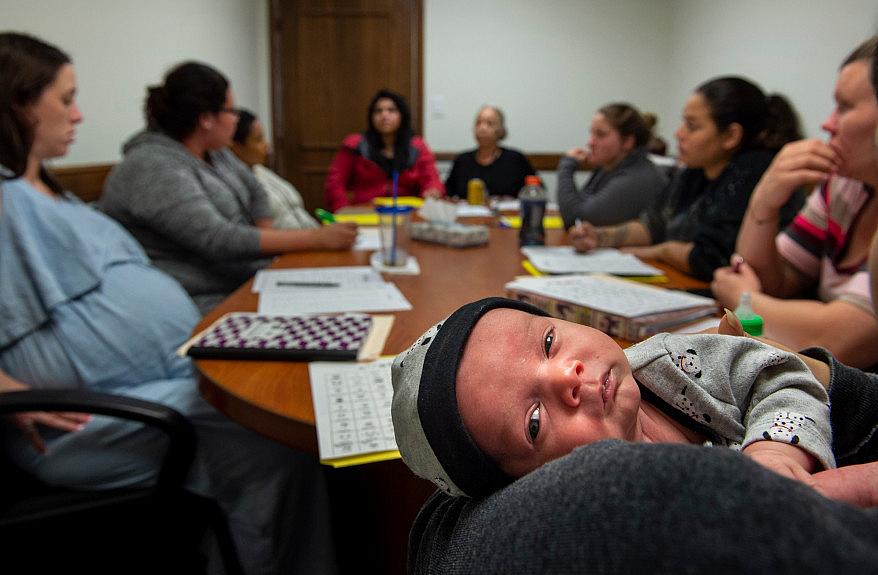
One-month-old baby Alexander is comfortable in his mom, Elia R’s arms during a group therapy session for women and mothers dealing with substance abuse in Orange.
(Photo Credit: Mindy Schauer, Orange County Register/SCNG)
Not so long ago, heroin had its hooks in her.
Her first baby, now a 1-year-old toddler, was swept into state custody in 2017. Her next baby was due at the end of 2018.
Tahtiana R. fiddled with the sheaf of papers on the conference table before her — writing assignments from the Mariposa Center, where she received counseling to help her accept, and transcend, a painful past.
She has done time in jail. She has been homeless. She has been “red-flagged” by California’s child protection system and, despite the warmth of the Casa Teresa emergency shelter for women that was now home, she felt gnawing anxiety.
What would happen at the hospital when she delivered? Would she be granted that precious, skin-to-skin contact with her baby? Would she be allowed the intimacy of nursing, of gazing into her newborn’s eyes?
Or would social workers whisk her baby away?
When Tahtiana found out she was pregnant again, she kicked heroin cold turkey. No medication-assisted treatment; just force of will. While doctors frown on that — it can cause seizures and threaten both mother and baby — Tahtiana is proud of her triumph.
“I wouldn’t have done it for myself,” she said.
Would social workers from Child Protective Services view her accomplishments in a similar light? That was a nagging unknown.
“They take the babies away and tell you they want nothing more than to see you reunited,” Tahtiana said. “But they don’t want it. They make it impossible for you to get them back.
“I lost my daughter,” she added. “I’m scared of them.”
She fiddled with the papers, eyes downcast, lips tight.
“Getting your baby taken away is the worst pain in the world.
Elia R leaves her support group with her daughter Annilee, 7, and her newborn baby Alexander in Orange. (Photo by Mindy Schauer, Orange County Register/SCNG)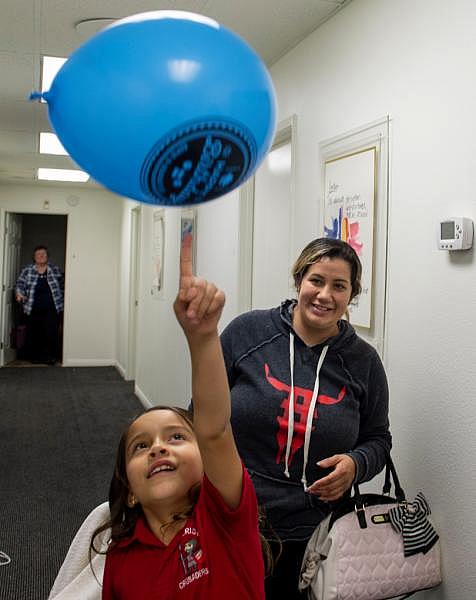
Calculated risk
Perhaps the most awesome power of government outside a criminal court is its power to cleave children from their parents forever. In California, it’s a drama that often plays out in non-criminal “dependency courts,” where life-altering decisions are made beyond the reach of public scrutiny.
The secrecy is meant to protect the privacy of all involved. But it frustrates some parents who believe they’ve been treated unfairly, and who assert that justice can die in its darkness.
When an infant tests “pos-tox” at birth — meaning they’ve been exposed to drugs in utero — a hospital social worker calls the county’s Child Protective Services team. Those CPS social workers — armed with checklists and lifetimes of experience — start asking questions:
Is the child in imminent danger? Has this family previously been investigated for neglect or abuse? Are there domestic violence allegations? Do they have a home? Jobs? Criminal history? Mental health issues? Is there a support system they can depend on?
Parental drug use alone is not grounds for removing a child in California; there must be other factors at play. How, then, to decide which babies are safe to stay with their parents, and which are not?
California attempts to standardize what could be a highly subjective inquiry by arming social workers with a trademark-protected Structured Decision Making tool. It assigns numeric values to each answer, ultimately placing families into one of four risk groups: low, medium, high or very high.
Even at its best, the assessment system is far from foolproof, and it can be overridden by social workers with heavy caseloads who try to concentrate their efforts on what appear to be the most dangerous cases.
After initial assessments, four things can happen:
- Nothing. If the social worker finds no evidence of abuse or neglect that requires court involvement – for example, if the mother is on doctor-prescribed pain medication and there are no other issues – no action is taken. Often, this happens with the vast majority of neglect and abuse reports. Often, these families scored “low” on the risk assessment.
- An offer of voluntary services. Social workers will try to connect parents with free counseling and classes to help them parent more safely. Parents aren’t required to accept these services. Often, these families scored “medium” on the risk assessment.
- A child-welfare case is opened. Children not in immediate danger can stay with their families, but the court will map out action plans for parents. They have a year or so to complete all of the tasks assigned, which can include substance abuse treatment, surprise drug testing, parenting classes, counseling and 12-step meetings. If parents are successful, the case is closed, the system gets out of the way and families get on with their lives. If the parents fail, the court can sever parental rights and put the children up for adoption. Often, these families scored “high” on the risk assessment.
- The child, or children, are removed from their family. When children are deemed to be in immediate danger, a welfare case is opened and children are placed with relatives or in a foster home. Cases unfold as above – culminating either in reunification or termination of parental rights. Often, these families scored “very high” on the risk assessment.
The vast majority of calls to CPS result in “nothing” and “an offer of voluntary services.” Only a fraction become open child welfare cases.
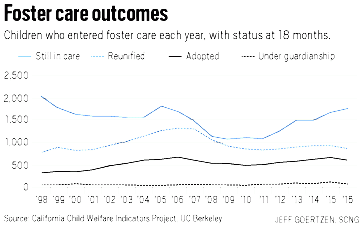
Statewide, for all kids under 18, social workers last year received 499,661 reports of suspected abuse or neglect. Less than 9 percent of those cases — 44,186 — resulted in open cases, according to state data.
The extreme vulnerability of infants, though, means many more reports connected to newborns (about 33 percent) translate into open cases.
While parents may fear social workers, the workers themselves rarely feel like powerful actors, said Jill Duerr Berrick, a professor in UC Berkeley’s School of Social Welfare, in her book, “The Impossible Imperative.”
“Constrained by limited agency resources, sometimes overlooked by judges or attorneys whose professional titles wield greater status, and too often targeted in the media when mistakes are made, child welfare workers carry out difficult work.”
The importance of that work can’t be exaggerated, she said. But things get complicated when the state plays parent.
Inside secret court
Santa Clara Superior Court Judge Erica Yew kept a fishbowl in her courtroom.
There were no fish inside, just colorful slips of paper; orange, yellow, green and white.
“The fishbowl is a popular incentive tool,” Yew explains in a script she co-authored for other judges, to help them orchestrate dependency drug treatment court. “Along with praise, gift cards for certain milestones, and providing certain items like toys, diapers, wipes and books, the fishbowl allows the Family Dependency Court to provide tangible validation of the parents’ success.”
Parents earned a trip to the fishbowl by successfully completing tasks required of them; passing their drug tests or completing various forms of addiction treatment and parenting classes. Orange slips could be exchanged for rewards such as sunglasses, a flashlight, or music. Yellow slips were geared to women; green slips, to men; and white slips taught parents to postpone immediate gratification.
Two white coupons could be exchanged for a $5 Starbucks card. Four earned a $10 Target card and so on, until eight earned “a big surprise!” — a portrait of parent and child, a digital camera with a memory card, or some other treasure donated by well-wishers or purchased with a grant.
“It is up to you. Just know we are proud of you for getting your fishbowl!” her script for judges says, followed by the direction: “Applause.”
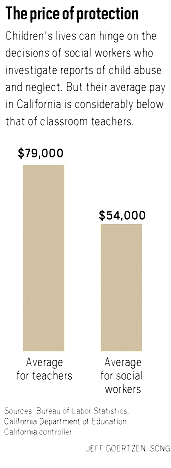
“Don’t underestimate the power of applause,” Yew admonished. “Some of our parents did not have many opportunities to be applauded before they entered Family Dependency Court.”
In 2007, Yew became the founding judge of Santa Clara County’s first dependency drug treatment court, and presided until 2011.
“Nothing in law school, and very little in legal practice, prepares a judge for the experience of not acting like a judge,” she wrote in the book “Family Drug Courts: An Innovation of Transformation.” “While detachment, and making decisions without being influenced by emotions, is essential to traditional judging, the recognition of and mastery of emotions is key to good drug court judging.”
Here, the judge was “team mom, team leader, team follower, coach, cheerleader, parent, guide, sherpa, hostess, facilitator, mediator, and more,” she wrote.
And packed into this courtroom — rather than two opposing sides — was the judicial equivalent of a cast of thousands.
A drug and alcohol rehabilitation counselor. A liaison from the County Mental Health Department. A domestic violence and trauma therapist. A resource specialist from First 5, the county’s early-childhood-services agency. Attorneys for the parents, the children, the county’s Department of Family and Children’s Services department and its social workers. The parent who must do the work, as well as the “mentor parent” — a been-there, done-that, successfully-survived-the-system parent who got the kids back and is living proof that the seemingly-impossible can, indeed, be done.
In 2007, Erica Yew became the founding judge of Santa Clara County’s first dependency drug treatment court, and presided until 2011. (Photo Credit: CaliforniaCourts via YouTube)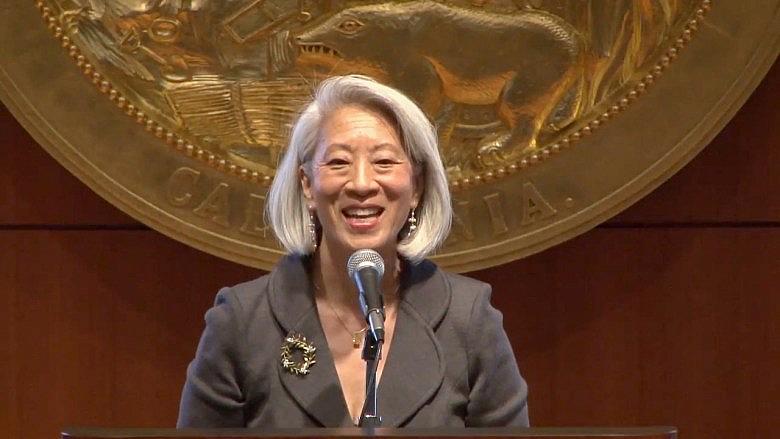
Santa Clara’s version had scores of partners trying to knit themselves together into a living safety net, raving about children’s progress the way a grandparent might. On offer was everything from financial aid, housing and drug treatment, to domestic violence support groups, job services, transportation and family planning; even tattoo removal was available. Children also got screening, assessments and, when needed, interventions to help keep them developmentally on track.
In the beginning, parents went to court weekly. They had to be in substance abuse treatment, drug test several times a week, attend 12-step meetings, enroll in a parenting program. Some parents breezed through quickly and graduated to Phase 2 with great fanfare from the court team; others never got beyond it.
In Phase 2, parents were in court every other week. In Phase 3, every three weeks. In Phase 4, every four weeks, until they completed all case plan goals and graduated — which meant they were ready for the rights and responsibilities of parenthood.
The mission, Yew said, was to re-parent the parents.
“Our parents are often hopeless when they enter our child welfare system. It is our job to be their beacons of hope until they learn to hope themselves,” she wrote.
Thirty-nine of California’s 58 counties have a version of this dependency drug court, including Los Angeles, Riverside, San Francisco and Sacramento, according to the Judicial Council of California. Alameda’s version has been likened to a revival meeting, where cheers erupt to mark parental progress and children are loved up with stickers and toys.
But even in those counties, cutbacks have meant some tasks were broken off into different courtrooms. Other counties have fewer such courts than they did a few years ago. Their success depends heavily on the personality of the judges and the buy-in of the social workers, participants said.
But, when it happens, success can be striking.
In Santa Clara, 90 percent of the parents Yew saw had a criminal history; 80 percent lived with domestic violence; 66 percent had annual incomes of less than $10,000; 65 percent were chronically homeless; and 40 percent were once foster children themselves.
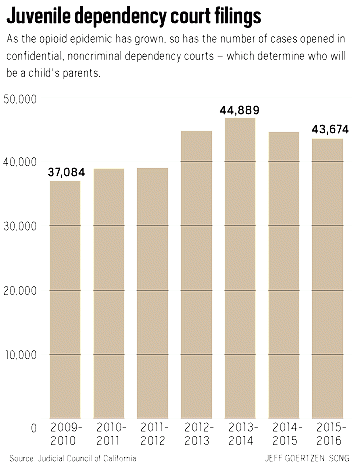
Yet while the overall parent-kid reunification rate was 53 percent in Santa Clara County, the family drug court clocked a 75 percent reunification rate.
And while 11 percent of kids who reunited with their parents eventually cycled back into the system, only about 1 percent of those in the wrap-around court did. Each child got “extraordinary services,” including early assessments as well as medical and mental health care. Graduates typically didn’t have repeated pos-tox births.
Among the 19 California counties that do not have family drug courts, Orange and San Bernardino are the largest. In those counties, parents can go many months without seeing a judge, and might not be “re-parented” with the same tender attention.
So little time
Amairany H. has a flair for the dramatic. She batted her false lashes coquettishly and burst into laughter as one came loose and stabbed her in the eye.
Her three children — 2, 4 and 5 — were removed from her care. She holds two jobs, rising at 5 a.m. to clean office buildings. She must also squeeze in a full menu of required classes, go to therapy, pass drug tests, attend 12-step meetings, spend time with her children, prove that she’s improving her parenting skills. She must navigate byzantine governmental systems and have her intimate relationships scrutinized for domestic violence. She lives in Costa Mesa and it takes her two hours by bus, each way, to get to the Mariposa Center in Orange. A two-hour counseling session becomes a seven-hour commitment.
“Sometimes I feel like it’s impossible,” she said. “They give you so little time. Please. Give us more time.”
Amairany H, left, cracks up counselor Sylvia Jacques, during an otherwise serious support group for pregnant women and mothers who are dealing with addiction. The meetings are run by the non-profit Mariposa which specializes in women’s health. (Photo Credit: Mindy Schauer, Orange County Register/SCNG)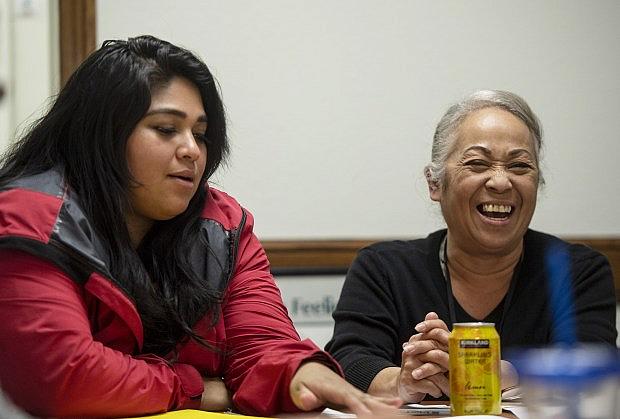
The U.S. Surgeon General defines addiction as a lifelong illness, saying it can take eight or nine years after a person first seeks formal help to achieve sustained recovery. But time is a luxury these parents don’t have.
If children are younger than six months old, mothers get six months to pull it together. If social workers feel mom is progressing — but is not completely ready — moms might get six more months from the judge.
Amairany has an older child, so she could get a bit more time on top of that, if her lawyer is solid and if social workers are inclined to look kindly upon her. But the one-year mark is usually where the child protection system’s preference for family reunification pivots toward permanency — finding stability for the children.
This is when the state often asks judges to terminate Mom’s (or Dad’s) parental rights, and the children go up for adoption.
It’s terrifying, how much power strangers have over their lives, the moms and moms-to-be said. It’s baffling, how getting their children back — or being allowed to keep them — can hinge so heavily on how well they click with a single social worker, lawyer or judge.
The women don’t ask questions because they don’t want to appear disrespectful, said Sylvia Jacques, the women’s counselor at Mariposa.
“They get intimidated,” she said. “I’ve witnessed so many who are really trying, but from Social Services’ point of view, it’s not good enough.
“If you go against Social Services, they can make your life kind of tough.”
Indeed. All Tahtiana could think about as she prepared to deliver her second baby was whether that baby would be taken into state custody, too — and what she could do to get her first baby back.
She closed the folder of soul-searching writing assignments on the table before her. “It’s easier to get high,” Tahtiana said.
Jacques held her eyes. “Don’t give up,” Jacques said.
Tahtiana sighed. “I won’t,” she said. “I won’t.”
[This story was originally published by The Orange County Register.]
